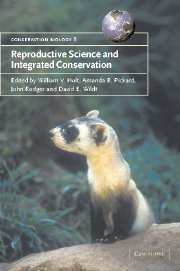Book contents
Part V - Reproduction science in non-mammalian species
Published online by Cambridge University Press: 21 January 2010
Summary
My own suspicion is that the universe is not only queerer than we suppose, but queerer than we can suppose.
J. B. S. Haldane (essay, ‘Possible Worlds’, 1927)A cursory glance at reproductive biology textbooks is enough to confirm that most biologists are exclusively mammal aficionados! Even then, most research is directed at the common mammals—domestic livestock, laboratory rodents and primates, and humans. There is a danger to this provincial approach, that is, that conventional wisdom on reproductive mechanisms is derived from a very few and (in the case of livestock and laboratory animals) genetically homogeneous groups of species. Thus, we teach the science of reproduction to our students on the basis of learned knowledge from an embarrassingly few and (in the opinion of the editors) rather boring, unidimensional species. As our text has emphasised, there are thousands of species that have never been studied. To do so would require armies of postdoctoral fellows and vastly expanded sources of funding. Take fishes as a prime example: rich diversity in taxonomy but also in the ways in which they reproduce. In this section a striking picture of this unbelievable diversity is presented. For species conservation, where knowledge of reproduction can be crucial to the appropriate design and implementation of conservation measures, how are we to prioritise studies on fish reproduction? Given that there are 24 000 species, should we only study those that can be used for food production?
- Type
- Chapter
- Information
- Reproductive Science and Integrated Conservation , pp. 319 - 320Publisher: Cambridge University PressPrint publication year: 2002

